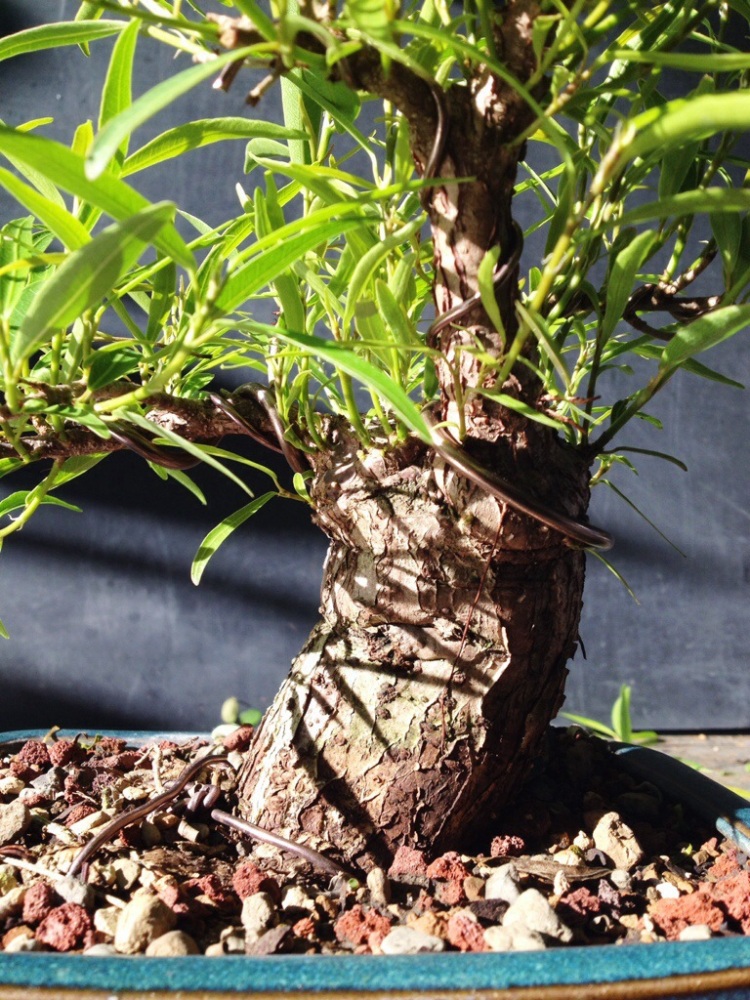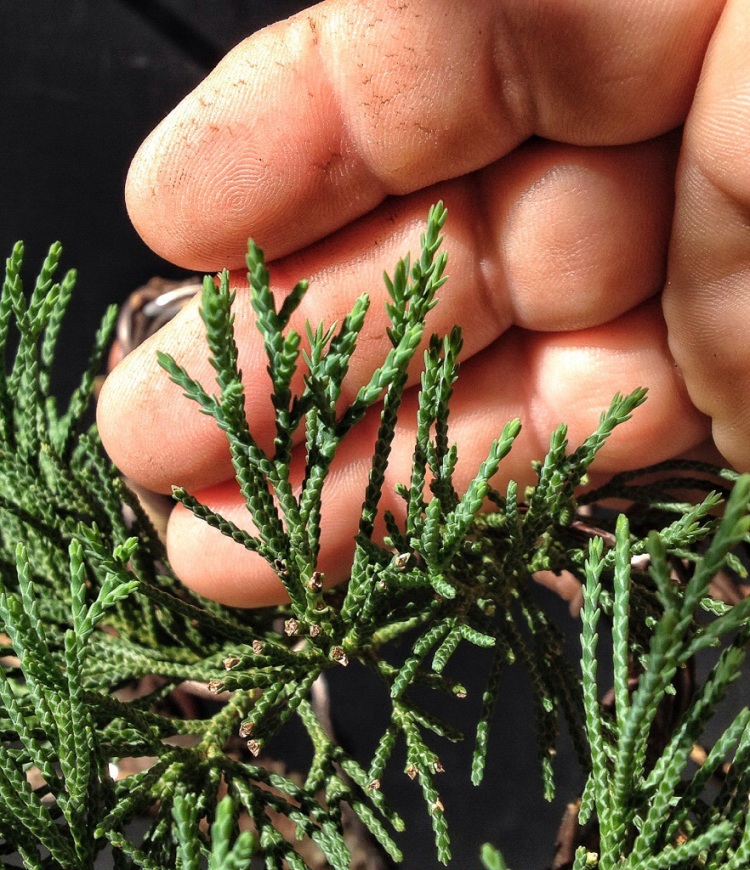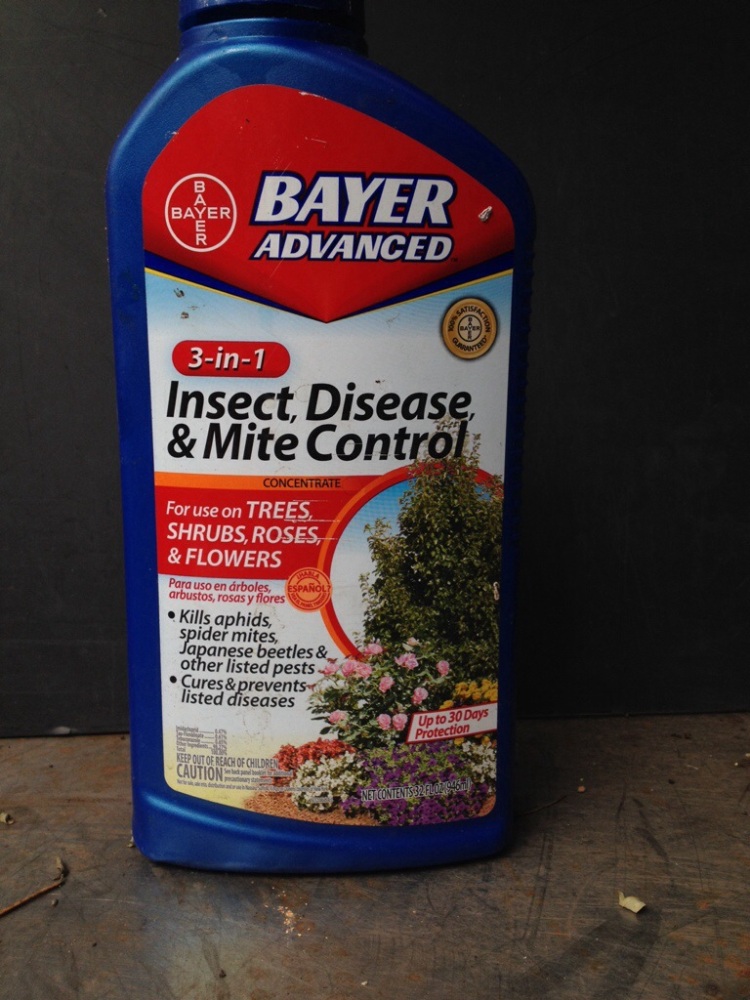Six trees. I’ll be brief (tough for me in text form I know, but if you meet me in person I am actually very quiet and of few words). I’ll try to be informative at the same time. I also need to warn you; there are no pretty “after” shots either. I apologize to my Instagram buddies as there’ll be no photogenically acceptable posts forthcoming. Not to mention the light was terrible for this photoset. Sorry. Let’s start with…..  A very bushy ficus salicaria. I would say it’s filled in well.
A very bushy ficus salicaria. I would say it’s filled in well.  The pic above was from this post which was published on August 16 2013. This bushiness is very typical behavior for a willow leaf ficus. It can be daunting.
The pic above was from this post which was published on August 16 2013. This bushiness is very typical behavior for a willow leaf ficus. It can be daunting.  This pic below shows an area I had to shave:
This pic below shows an area I had to shave:  In that little band (about 1/4 inch thick and a little more than an inch wide) there were more than 30 shoots. Inconceivable. Can you imagine if the Japanese had this species a hundred years ago? In a way I’m kinda glad that we have it now because it’s up to us to figure it out. And we growers and artists in Florida are at the forefront. One of those artists is Ed Trout. He is touring the country this year giving demos and leading workshops. If he is close by your town, and you get the chance, go see him. I highly recommend it. This is one of his trees:
In that little band (about 1/4 inch thick and a little more than an inch wide) there were more than 30 shoots. Inconceivable. Can you imagine if the Japanese had this species a hundred years ago? In a way I’m kinda glad that we have it now because it’s up to us to figure it out. And we growers and artists in Florida are at the forefront. One of those artists is Ed Trout. He is touring the country this year giving demos and leading workshops. If he is close by your town, and you get the chance, go see him. I highly recommend it. This is one of his trees:  And here is the man himself:
And here is the man himself:  Always a smile, a joke and a kind word. He is one of the true gentleman of bonsai (unlike me, I’m gruff and taciturn at best) He will be at Wigert’s Bonsai’s open house this year (November 2-3 www.wigertsbonsai.com) And I am excited to say, one of the headliners for the 2014 Bonsai Societies of Florida annual convention, alongside Peter Warren and Enrique Castano. More on that as we get closer but mark the calendar; May 23-26 2014. So here’s the tree with all of the unnecessary growth pruned away (like a bikini wax almost).
Always a smile, a joke and a kind word. He is one of the true gentleman of bonsai (unlike me, I’m gruff and taciturn at best) He will be at Wigert’s Bonsai’s open house this year (November 2-3 www.wigertsbonsai.com) And I am excited to say, one of the headliners for the 2014 Bonsai Societies of Florida annual convention, alongside Peter Warren and Enrique Castano. More on that as we get closer but mark the calendar; May 23-26 2014. So here’s the tree with all of the unnecessary growth pruned away (like a bikini wax almost).  Then a topiary trim except for this apex branch-
Then a topiary trim except for this apex branch-  And these back buds-
And these back buds-  The new branches are too young to wire, so that’s it.
The new branches are too young to wire, so that’s it.  There’s a definite improvement but it’s not pretty. This is the theme of the post. Next tree is the ficus triangular from this post
There’s a definite improvement but it’s not pretty. This is the theme of the post. Next tree is the ficus triangular from this post  The progress on this tree is the improved health, the wire has set the main branches (which I removed about a month ago) and the shorter internodes. When last you saw it it looked like so-
The progress on this tree is the improved health, the wire has set the main branches (which I removed about a month ago) and the shorter internodes. When last you saw it it looked like so-  You may think I’ve let it go, but no, I’m letting it grow……get it, go….grow…? Waka waka!! Seriously though, I’m not sure how winter will treat this tree here in Orlando so I’m being a bit cautious with it. An abundance of leaf surface area will make for better transpiration (the process that ultimately leads to water usage, which is something I’m concerned about in this shallow pot. Shallow pots don’t drain as well as deep pots. Don’t believe me? Look up “perched water table” in containers). And more leave surface area means better photosynthesis, how a plant makes food (and you thought you were “feeding” it with fertilizer. Nope. Think of fertilizer loosely like vitamins). Lookie here!
You may think I’ve let it go, but no, I’m letting it grow……get it, go….grow…? Waka waka!! Seriously though, I’m not sure how winter will treat this tree here in Orlando so I’m being a bit cautious with it. An abundance of leaf surface area will make for better transpiration (the process that ultimately leads to water usage, which is something I’m concerned about in this shallow pot. Shallow pots don’t drain as well as deep pots. Don’t believe me? Look up “perched water table” in containers). And more leave surface area means better photosynthesis, how a plant makes food (and you thought you were “feeding” it with fertilizer. Nope. Think of fertilizer loosely like vitamins). Lookie here!  Them’s look like fruit. They ain’t …um, they’re not. Those are ficus flower bodies. The unmentionable bits are inside this little hole on the end:
Them’s look like fruit. They ain’t …um, they’re not. Those are ficus flower bodies. The unmentionable bits are inside this little hole on the end:  And it takes a specialized wasp with a long, thin, thingy to pollinate it. I don’t think those wasps live in Orlando. They might though, every thing else is an import. Even Walt Disney was from Chicago. The next tree, or trees, are Chinese elms from this post.
And it takes a specialized wasp with a long, thin, thingy to pollinate it. I don’t think those wasps live in Orlando. They might though, every thing else is an import. Even Walt Disney was from Chicago. The next tree, or trees, are Chinese elms from this post. 
 I do believe these trees have stopped growing mostly.
I do believe these trees have stopped growing mostly.  A quick trim-
A quick trim-  Yes, I think it’s time to sacrifice the, uh, sacrifice branch. And after a quick trim-
Yes, I think it’s time to sacrifice the, uh, sacrifice branch. And after a quick trim-  Now for a (partial) failure report. The juniper from this post. How we left it:
Now for a (partial) failure report. The juniper from this post. How we left it:  How it is today:
How it is today:  Two dead branches. The top is growing well though. When I wrote the original post I had warned that the bark and cambium were “slippery” in the summer in Florida. And that wiring and moving branches was sometimes risky. I proved my point I guess. I didn’t kill the whole branch back to the trunk; these two secondary branches are the dead ones-
Two dead branches. The top is growing well though. When I wrote the original post I had warned that the bark and cambium were “slippery” in the summer in Florida. And that wiring and moving branches was sometimes risky. I proved my point I guess. I didn’t kill the whole branch back to the trunk; these two secondary branches are the dead ones- 
 But this third one is healthy and growing:
But this third one is healthy and growing:  You could say it’s the main branch even. The rest of the tree is pushing growth too-
You could say it’s the main branch even. The rest of the tree is pushing growth too-  The only thing to do is….snip!
The only thing to do is….snip!  On to the last tree! This is the ilex from Walmart (this post) What has gone before…
On to the last tree! This is the ilex from Walmart (this post) What has gone before…  And now-
And now-  Whoa! Don’t you ever trim that bush. It’s like a 1970’s…….never mind, I won’t go there. Let’s talk fungus on ilex vomitoria. One of the biggest contributors to black spot fungus on ilex is reduced air flow.
Whoa! Don’t you ever trim that bush. It’s like a 1970’s…….never mind, I won’t go there. Let’s talk fungus on ilex vomitoria. One of the biggest contributors to black spot fungus on ilex is reduced air flow.  The canopy on this little tree is just too dense (like me, sometimes). The ilex will almost self-prune itself when the canopy is this thick, which the brown tipped leaves represent. The leaves with the black spots on them are, duh, black spot disease. I use this product
The canopy on this little tree is just too dense (like me, sometimes). The ilex will almost self-prune itself when the canopy is this thick, which the brown tipped leaves represent. The leaves with the black spots on them are, duh, black spot disease. I use this product  normally, with this active ingredient-
normally, with this active ingredient-  But I couldn’t find it so I got this one-
But I couldn’t find it so I got this one-  Which has the same active fungicide:
Which has the same active fungicide:  Just not as high a percentage. First, trimming (it’s not very healthy to touch a recently sprayed plant. And it makes your tacos taste funny) and then spraying. Half trimmed:
Just not as high a percentage. First, trimming (it’s not very healthy to touch a recently sprayed plant. And it makes your tacos taste funny) and then spraying. Half trimmed:  And all the way trimmed. Side view:
And all the way trimmed. Side view:  And the front:
And the front:  I tipped all the branches except the apex (again)
I tipped all the branches except the apex (again)  And that’s all. A totally un-glamorous post on maintenance that no one hardly ever shows in these progression pieces. I hope it was informative. And the last bit of advice: Keep those bushes trimmed, ya hear?
And that’s all. A totally un-glamorous post on maintenance that no one hardly ever shows in these progression pieces. I hope it was informative. And the last bit of advice: Keep those bushes trimmed, ya hear?
- Comment
- Reblog
-
Subscribe
Subscribed
Already have a WordPress.com account? Log in now.
Thanks for this post. I think it’s important to show the in between stages of development. One of the most difficult things I learned when new to bonsai was that my trees would NOT look like “bonsai” most of the time while on the bench. Waiting in the hardest part.
LikeLike
Good post! Coincidentally, I have a ficus salicaria that I let get a little too out of control this summer. I didn’t want to cut the top though, thinking it would help speed up the development of the root system that I have been working on. I’ll probably make a post about it in the next couple of days.
LikeLike
These are exactly the type of posts that I need. Thanks, man.
LikeLike